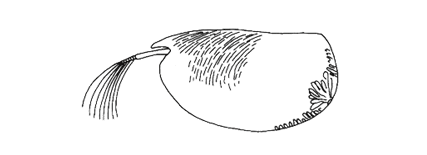Ostracoda
Dana 1852
Taxonomy
| Phylum | Arthropoda |
| Subphylum | Crustacea |
| Class | Ostracoda |
Size
- Pelagic ostracods are small, usually less than 2mm.
Distinguishing characteristics
- On first appearance have some resemblance to cladocerans. However, ostracods differ in that the body is completely enclosed in a clam-like bivalve shell that is hinged dorsally.
- A transverse adductor muscle, similar to that in clams and mussels, closes the shell.
- The carapace (shell) can have various shapes but is typically circular, elliptical, or almost rectangular.
- There is often an anterior antennal notch (not clearly visible on image).
- The carapace can be smooth, thin, and transparent in planktonic ostracods, while benthic forms have more robust, ornate shells.
- The trunk is reduced and unsegmented with 2 or less appendages, much fewer than other adult crustaceans. The abdomen is also reduced.
- Both the first and second antennae are well developed, extend beyond the carapace, and are the main swimming appendages.
Distribution
- They are not particularly common in coastal plankton samples.
- Benthic samples may be collected when sampling close to the bottom or close in to the shore.
Example of an ostracod


